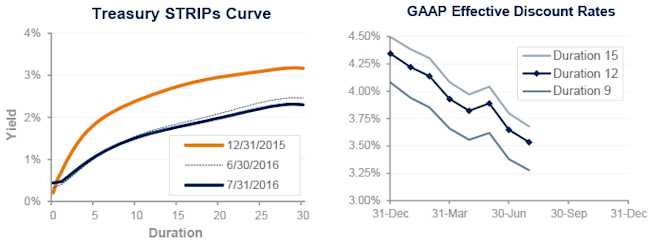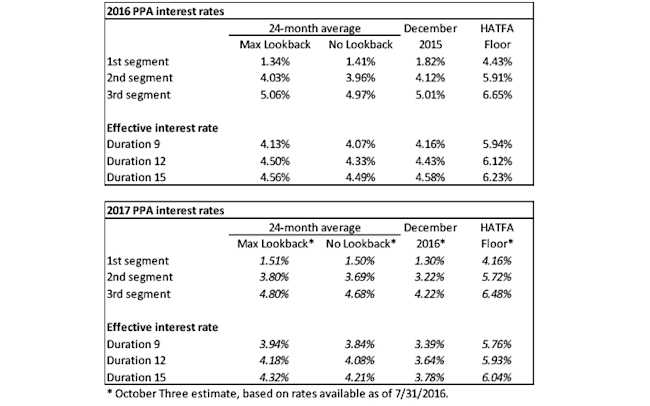July 2016 Pension Finance Update
[Note: we have refined our liability estimates below, producing minor differences with previous months.] July was a mixed month for pension sponsors. On one hand, interest rates ended the month at all-time low levels, pushing up pension liabilities. On the other hand, stock markets posted solid gains for the month and are now in healthy positive territory for the year. Overall, the news was good for both model pension plans we track1 – Plan A improved 2% last month but remains down 6% for the year through July, while Plan B gained 1% and is now down just 1% for 2016 so far:

Assets
July was a good month for stocks: the S&P 500 gained close to 4%, the NASDAQ surged more than 6%, the small-cap Russell earned 6%, and the overseas EAFE index was up more than 4%. For the year, the S&P 500 is up more than 7%, the NASDAQ is up 3%, the Russell 2000 is up almost 8%, and the EAFE index is flat.
A diversified stock portfolio gained 4%-5% during July and is now up 5% through the first seven months of 2016.
Interest rates fell again in July, marking the sixth monthly drop in the first seven months of 2016. Declining rates boost bond prices; both Treasuries and corporates gained about 1% in July, with long-term bonds outperforming. For the year, bonds are now up 8%-10%, with longer duration bonds enjoying the best results.
Overall, our traditional 60/40 portfolio gained 3% during July and is up more than 6% so far this year, while the conservative 20/80 portfolio added 2% last month and is now up 9% so far during 2016.
Liabilities
Pension liabilities (for funding, accounting, and de-risking purposes) are now driven by market interest rates. The graph on the left compares Treasury STRIPs yields at December 31, 2015 and July 31, 2016, and also shows the movement in rates last month. The graph on the right shows our estimate of movements in effective GAAP discount rates for pension obligations of various duration during 2016:

Both Treasury and corporate interest rates fell another 0.1% during July and are down more than 0.80% this year. The move pushed pension liabilities up 1% last month; liabilities are now 10%-15% higher than at the end of 2015, with long duration plans seeing the biggest increases.
Summary
2016 has been a decent year for pension assets, but the dominant theme remains all-time low interest rates and their effect on pension liabilities. The 30-year Treasury reached its all-time low yield of 2.11% on July 8 before drifting up to 2.18% by month’s end.
Rates could move lower still, but if we are near the bottom and rates move up in the months ahead, the headwind of pension liabilities could become a tailwind for plan sponsors.
The graphs below show the movement of assets and liabilities for our two model plans this year:

Looking Ahead
The Obama Administration and Congressional leaders passed a budget last fall that includes a third round of pension funding relief since 2012. The upshot is that pension funding requirements over the next several years will not be appreciably affected by current low interest rates (unless these rates persist). Required contributions for the next few years will be lower and more stable than under prior law.
Discount rates fell another 0.1% last month. We expect most pension sponsors will use effective discount rates in the 3.2%-3.8% range to measure pension liabilities right now. These rates are as low as we’ve ever seen.
The table below summarizes rates that plan sponsors are required to use for IRS funding purposes for 2016, along with estimates for 2017. Pre-relief, both 24-month averages and December ‘spot’ rates, which are still required for some calculations, such as PBGC premiums, are also included.

1 Plan A is a traditional plan (duration 12 at 5.5%) with a 60/40 asset allocation, while Plan B is a cash balance plan (duration 9 at 5.5%) with a 20/80 allocation with a greater emphasis on corporate and long-duration bonds. For both plans, we assume the plan is 100% funded at the beginning of the year and ignore benefit accruals, contributions, and benefit payments in order to isolate the financial performance of plan assets versus liabilities.
